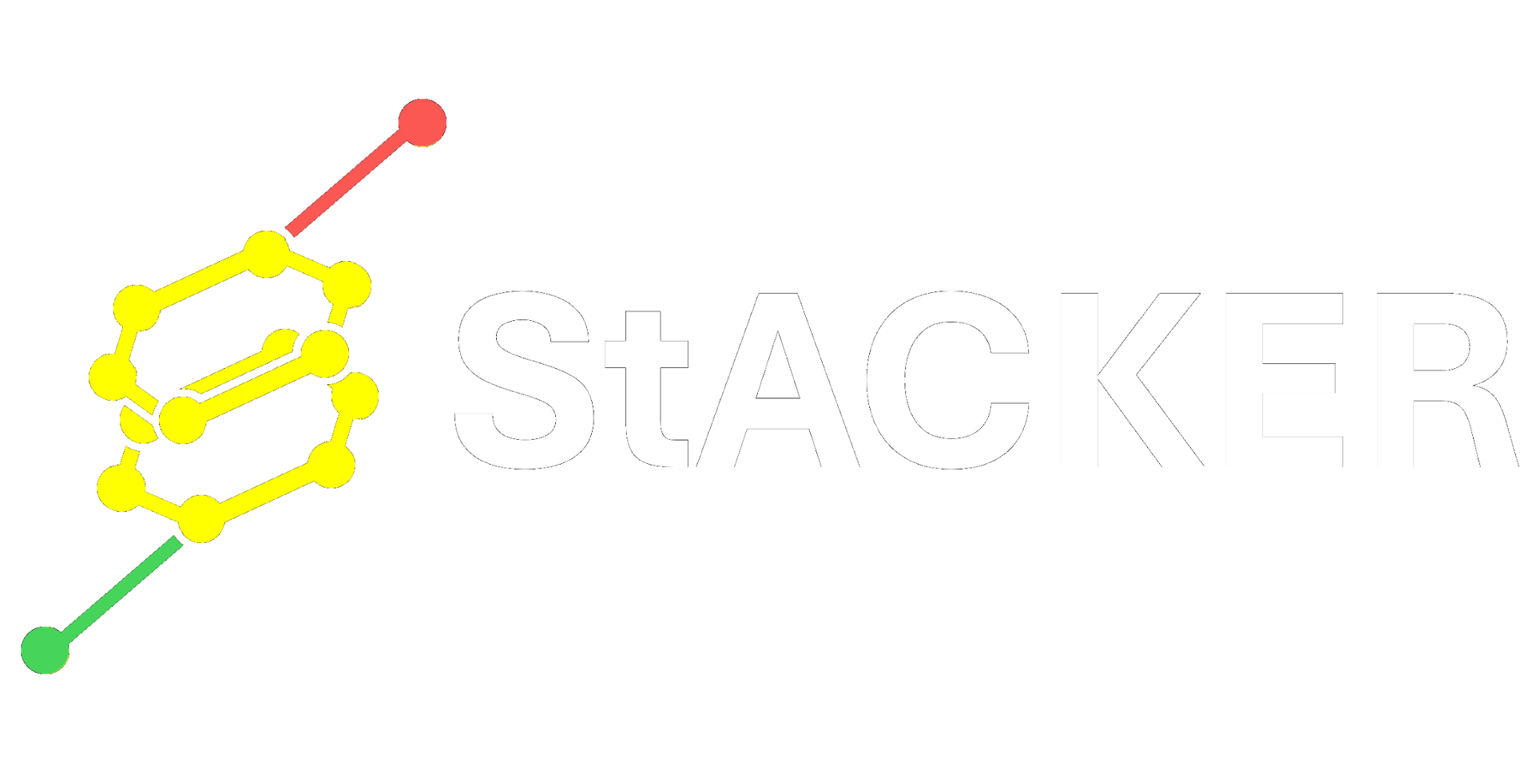stacker.file_manipulation module#
Filter Trajectory Files
This module contains functions for manipulating trajectory files. This includes filtering a trajectory to desired atoms, converting trajectory filetype, and outputting Python trajectories to other filetypes (eg. prmtop, mdcrd, pdb)
- filter_traj(trj_file, top_file, residues={}, atoms={})[source]#
Filters an input trajectory to only the specified atoms and residues
Filteres an input trajectory that contains all of the atoms in a topology to only the desired atoms at the desired residues (eg. the atoms necessary to find the center of geometry of a residue). If
residuesoratomsare empty, all residues or atoms are included respectively.- Parameters:
- trj_filestr
filepath of the trajectory
- top_filestr
filepath of the topology of the molecule
- residuesset or str
1-indexed residue numbers of residues to keep in the trajectory. Accepts smart-indexed str representing a list of residues (e.g ‘1-5,6,39-48’). If Empty, include all residues.
- atomsset
atomnames to keep in the trajectory. If Empty, include all atoms.
- Returns:
- filtered_trajectorymdtraj.Trajectory
a trajectory object representing the filtered structure across all frames
See also
filter_traj_to_pdbFilters an input trajectory to only the specified atoms and residues and outputs to pdb
mdtraj.TrajectoryThe Trajectory object in mdtraj package
Notes
Inputed trajectory should have 1-indexed Residue Indices, Outputed trajectory object will be 0-indexed.
Examples
>>> import stacker as st >>> filtered_traj = st.filter_traj('stacker/testing/first10_5JUP_N2_tUAG_aCUA_+1GCU_nowat.mdcrd', ... 'stacker/testing/5JUP_N2_tUAG_aCUA_+1GCU_nowat.prmtop', ... residues = {426,427}, ... atoms = {'C2','C4','C6'}) WARNING: Residue Indices are expected to be 1-indexed Reading trajectory... Reading topology... Filtering trajectory... WARNING: Output filtered traj atom, residue, and chain indices are zero-indexed >>> table, bonds = filtered_traj.topology.to_dataframe() >>> print(table) serial name element resSeq resName chainID segmentID 0 None C6 C 425 G 0 1 None C2 C 425 G 0 2 None C4 C 425 G 0 3 None C6 C 426 C 0 4 None C4 C 426 C 0 5 None C2 C 426 C 0
Residue Number support SmartIndexing
>>> import stacker as st >>> filtered_traj = st.filter_traj('../testing/first10_5JUP_N2_tUAG_aCUA_+1GCU_nowat.mdcrd', ... '../testing/5JUP_N2_tUAG_aCUA_+1GCU_nowat.prmtop', ... residues = '1-16,25,50-57', ... atoms = {'C2','C4','C6'}) WARNING: Residue Indices are expected to be 1-indexed Reading trajectory... Reading topology... Filtering trajectory... WARNING: Output filtered traj atom, residue, and chain indices are zero-indexed >>> filtered_traj <mdtraj.Trajectory with 10 frames, 75 atoms, 25 residues, without unitcells at 0x1156c3ed0>
- filter_traj_to_pdb(trj_file, top_file, pdb, residues={}, atoms={})[source]#
Filters an input trajectory to only the specified atoms and residues and outputs to pdb
Filteres an input trajectory that contains all of the atoms in a trajectory to only the desired atoms at the desired residues (eg. the atoms necessary to find the center of geometry of a residue) and writes the output to a specified pdb file. If residues or atomnames are empty, all residues or atoms are included respectively.
- Parameters:
- trj_filestr
path to file of the concatenated trajectory. Should be resampled to the 1 in 50 frames sampled trajectories for each replicate.
- top_filestr
path to file of the topology of the molecule
- pdbstr
path to the output pdb file
- residuesset or str
1-indexed residue numbers of residues to keep in the trajectory. Accepts smart-indexed str representing a list of residues (e.g ‘1-5,6,39-48’) If Empty, include all residues.
- atomnamesset
atomnames to keep in the trajectory
- Returns:
- None
See also
filter_trajFilters an input trajectory to only the specified atoms and residues
Notes
Inputed trajectory should have 1-indexed Residue Indices, Outputed trajectory object will be 0-indexed.
- file_convert(trj_file, top_file, outfile)[source]#
Converts a trajectory input file to a new output type.
The output file type is determined by the
outfileextension. Usesmdtraj.save()commands to convert trajectory files to various file types such asmdtraj.save_mdcrd(),mdtraj.save_pdb(),mdtraj.save_xyz(), etc.- Parameters:
- trj_filestr
Path to the file of the concatenated trajectory (eg. .mdcrd file).
- top_filestr
Path to the file of the topology of the molecule (.prmtop file).
- outfilestr
Output filename (include .mdcrd, .pdb, etc.).
- Returns:
- None
See also
mdtraj.loadLoad trajectory files
mdtraj.saveSave md.Trajectory to file
mdtraj.load_xyzLoad a .xyz trajectory file
Notes
Output filetype determined from file extension of output_file parameter.
Examples
>>> import stacker as st >>> import mdtraj as md >>> st.file_convert('stacker/testing/first10_5JUP_N2_tUAG_aCUA_+1GCU_nowat.mdcrd', ... 'stacker/testing/5JUP_N2_tUAG_aCUA_+1GCU_nowat.prmtop', ... 'stacker/testing/first10_5JUP_N2_tUAG_aCUA_+1GCU_nowat.xyz') WARNING: Output file atom, residue, and chain indices are zero-indexed Trajectory written to: stacker/testing/first10_5JUP_N2_tUAG_aCUA_+1GCU_nowat.xyz >>> md.load_xyz('stacker/testing/first10_5JUP_N2_tUAG_aCUA_+1GCU_nowat.xyz', ... top='stacker/testing/5JUP_N2_tUAG_aCUA_+1GCU_nowat.prmtop') <mdtraj.Trajectory with 10 frames, 12089 atoms, 494 residues, without unitcells at 0x10bb75cd0>
- class SmartIndexingAction(option_strings, dest, nargs=None, const=None, default=None, type=None, choices=None, required=False, help=None, metavar=None, deprecated=False)[source]#
Bases:
ActionCustom argparse action to handle smart indexing of frame numbers.
Parses a comma-separated list of frame numbers with optional ranges (e.g., ‘1-20, 34, 25, 50-100’) and generates a list of individual frame numbers. Modifies the namespace by setting the attribute specified by the ‘dest’ parameter to the list of individual frame numbers.
- Parameters:
- parser: argparse.ArgumentParser
The argparse parser object.
- namespace: argparse.Namespace
The argparse namespace.
- values: str
The input string containing frame numbers and ranges.
- option_string: str, default=None
The option string.
- Attributes:
- deststr
The attribute name in the namespace where the parsed list will be stored.
Methods
__call__(parser, namespace, values, option_string=None)
Parses the provided string of values into a sorted list of integers and sets it as an attribute in the namespace.
Examples
>>> parser = argparse.ArgumentParser() >>> parser.add_argument("-fl", "--frame_list", metavar="FRAME_LIST", help="Smart-indexed list of 1-indexed Frame Numbers within trajectory to analyze", required=False, action=SmartIndexingAction) >>> args = parser.parse_args(["-fl", "1-20,34,25,50-100"]) >>> print(args.frame_list) [1, 2, ..., 20, 34, 25, 50, 51, ..., 100]
- static parse_smart_index(value)[source]#
Checks that an inputted variable is a list that can be smart indexed and indexes it if necessary.
- Parameters:
- value{str, set, list}
The input string containing ranges (e.g., “1-5,10,15-20”) or a set of integers.
- Returns:
- set
A set of integers parsed from the input.
- Raises:
- ValueError
If the input is not a string or set.
Examples
>>> import stacker as st >>> st.SmartIndexingAction.parse_smart_index('1-5,8,12-17') {1, 2, 3, 4, 5, 8, 12, 13, 14, 15, 16, 17}
- __init__(option_strings, dest, nargs=None, const=None, default=None, type=None, choices=None, required=False, help=None, metavar=None, deprecated=False)#
- _get_args()#
- _get_kwargs()#
- format_usage()#
